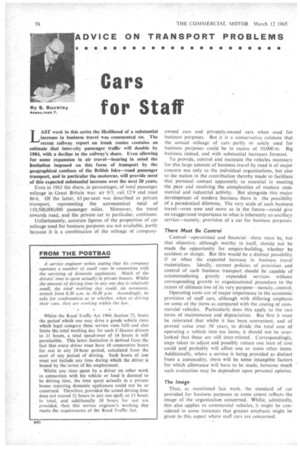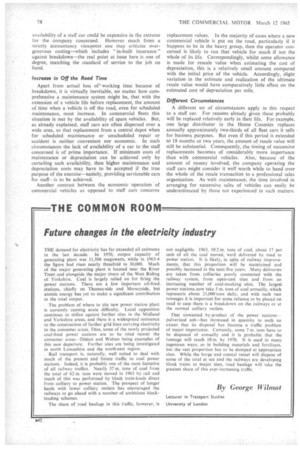Cars for Staff
Page 78

Page 79

Page 80

If you've noticed an error in this article please click here to report it so we can fix it.
By S. Buckley LAST week in this series the likelihood of a substantial increase in business travel was commented on. _ The recent railway report on trunk routes contains an estimate that inter-city passenger traffic will double by 1984, with a decline in the railway's share. Even allowing for some expansion in air traVel—bearing in mind the limitation imposed on this form of transport by the geographical confines of the British Isles—road passenger transport, and in particular the motorcar, will provide most of this expected substantial increase over the next 20 years.
Even in 1963 the share, in percentages, of total passenger mileage in Great Britain was: air 0.5, rail 12.9 and road 86.6. Of the latter, 63 per cent was described as private transport, representing the astronomical total of 110,500,000,000 passenger miles. Moreover, the trend towards road, and the private car in particular, continues.
• Unfortunately, accurate figures of the proportion of car mileage used for business purposes are not available, partly because it is a combination of the mileage of company
owned cars and privately-owned cars when used for business purposes. But it is a conservative estimate that the annual mileage of cars partly or solely used for business purposes could be in excess of 10,000 m. Big business indeed, and with substantial increases forecast.
To provide, control and maintain the vehicles necessary for this large amount of business travel by road is of major concern not only to the individual organizations, but also to the nation in the contribution thereby made to facilitate that personal contact apparently so essential in meeting the pace and resolving the complexities of modern commercial and industrial activity. But alongside this major development of modern business there is the possibility of a paradoxical dilemma. The very scale of such business travel—even now and more so in the future---could give an exaggerated importance to what is inherently an ancillary service—namely, provision of a car for business purposes.
There Must Be Control
Control—operational and financial --there must be, but that objective, although worthy in itself, should not be made the opportunity for empire-building, whether by accident or design. But this would be a distinct possibility if or when the expected increase in business travel materializes. Ideally, current policies of provision and control of such business transport should be capable of accommodating greatly expanded services without corresponding growth in organizational procedure to the extent of ultimate loss of its very purpose—namely, control, Operating costs are of major importance in the economic provision of staff cars, although with differing emphasis on some of the items as compared with the costing of commercial vehicles. Particularly does this apply to the two items of maintenance and depreciation. But first it must be reiterated that whilst it has been convenient, and of proved value over 50 years, to divide the total cost of operating a vehicle into ten items, it should not be overlooked that these are still inter-related. Correspondingly, steps taken to adjust and possibly reduce one item of cost could and probably will affect one or more other items. Additionally, where a service is being provided as distinct from a commodity, there will be some intangible factors for which allowance will have to be made, however much such evaluation may be dependent upon personal opinion,
The Image
Thus, as mentioned last week, the standard of car provided for business purposes to some extent reflects the image of the organization concerned. Whilst, admittedly, this also applies to commercial vehicles, it might be considered in some instances that greater emphasis might he given to this aspect where staff cars are concerned, Maximum availability of vehicles is an obvious requirement in all circumstances, but in the provision of staff cars it has a special significance. Where a fleet of commercial vehicles is based on a depot it is common practice to have a preventive maintenance scheme so arranged that a small percentage of vehicles—for example, 10—can be withdrawn from service for the necessary maintenance and repairs to be undertaken. But this is a practical proposition only where a sufficient number of vehicles are based on one depot, or at least in one relatively small area. The reason for this is that the empty, and therefore non-productive, mileage involved bringing such vehicles to the repair depot for servicing may well make the whole exercise uneconomic.
Maintenance Policy Unfortunately, from the point of view of economic maintenance based on a single depot, such a policy often is not suitable for a fleet of staff cars. Particularly where these are provided for a staff of widely dispersed salesmen (and often on a nation-wide basis in these days of large mergers) the disposition of such a fleet often will constitute single vehicles, each centred in a territory of its own. Such a set of circumstances is by no means uncommon and often is the determining factor in the method of providing adequate maintenance, rather than a decision solely on alternative costs.
Where, for these reasons, it becomes apparent to a company wishing to have available a fleet of staff cars that it would not be geographically convenient or economic to do its own maintenance, such recognition might raise other issues. In such circumstances the vehicle could be purchased by the company and subsequently the maintenance could be contracted out on the basis of the several manufacturing voucher schemes now available,
When considering the possiblity of obtaining maintenance on contract, the opportunity could also be taken to analyse the value of outright contract of the vehicle on hire. As with any form of service—whether transport or finance facilities—the provider of such a service requires payment for such service over and above its actual cost. The difference would comprise overhead costs and profit margin. Accordingly, it would normally be considered that this was a dearer proposition than providing such service oneself where this is possible. Here again, however, there are other factors to be taken into consideration, some of which, at least, are not readily quantifiable.
Capital Outlay
In circumstances where a maintenance depot is not already established to meet the need of a commercial fleet of ancillary vehicles, then the capital outlay on buildings and maintenance equipment and the subsequent payment of maintenance staff can be reasonably estimated. But unless the maintenance depot concerned is so large as to justify its own administrative staff, in addition to operatives (which would be most exceptional) then the addition of a maintenance depot to the organization as a whole should not be entered into too lightly.
In the vast majority of cases, the company's existing administrative and office staff would be involved in the purchasing. checking and payment for equipment and spares regularly required for maintenance purposes. When so stated this may appear a relatively routine task. But, as recent reports confirm, the supply of replacement units and spares is by no means as reliable and universal as might be expected. Only those who have had the job to do can appreciate fully the frustration and time-wasting effort
required to first locate and then obtain (often at the expense of totally uneconomic service van miles) the all-important spare part to put a vehicle back on the road. But although not quantifiable, such diversion of time from other and more basic duties can be an actual loss to the company's activities as a whole.
Closely allied to the method of providing maintenance is the debatable decision as to the optimum period at which to replace a staff car. Here again, as with maintenance, the circumstances on which such a decision is made are not directly comparable with those applying to commercial vehicles. In both cases, admittedly, a reliable and roadworthy vehicle would be required by any responsible operator. But over and above this, there would be an even greater emphasis in the case of staff cars that they should be absolutely reliable, bearing in mind that on the basis of salary alone, apart from any sales that may be made, one day lost of useful employment because of non
availability of a staff car could be expensive in the extreme for the company concerned. However much from a strictly accountancy viewpoint one may criticize overgenerous costing—which includes "in-built insurance" against breakdown—the real point at issue here is one of degree, matching the standard of service to the job on hand.
Increase in Off the Road Time Apart from actual loss of working time because of breakdown, it is virtually inevitable, no matter how comprehensive a maintenance system might be, that with the extension of a vehicle life before replacement, the amount of time when a vehicle is off the road, even for scheduled maintenance, must increase. In commercial fleets this situation is met by the availability of spare vehicles. But, as already explained, staff cars are often dispersed over a wide area, so that replacement from a central depot when for scheduled maintenance or unscheduled repair or accident is neither convenient nor economic. In such circumstances the lack of availability of a car to the staff concerned is of prime importance. If minimum costs of maintenance or depreciation can be achieved only by curtailing such availability, then higher maintenance and depreciation costs may have to be accepted if the true purpose of the exercise—naniely, providing serviceable cars
for staff—is to be achieved. Another contrast between the economic operation of commercial vehicles as opposed to staff cars concerns replacement values. In the majority of cases where a new commercial vehicle is put on the road, particularly if it happens to be in the heavy group, then the operator concerned is likely to run that vehicle for much if not the whole of its life. Correspondingly, whilst some allowance is made for reseale value when estimating the cost of depreciation, this is a relatively small amount compared with the initial price of the vehicle. Accordingly, slight variation in the estimate and realization of the ultimate resale value would have comparatively little effect on the estimated cost of depreciation per mile.
Different Circumstances A different set of circumstances apply in this respect to a staff car. For reasons already given these probably will be replaced relatively early in their life. For example, one large distributor in the Home Counties replaces annually approximately two-thirds of all fleet cars it sells for business purposes. But even if this period is extended to 18 months or two years, the amount of resale value will still be substantial. Consequently, the timing of successive replacements becomes of considerably more importance than with commercial vehicles. Also, because of the amount of money involved, the company operating the staff cars might consider it well worth while to hand over the whole of the resale transaction to a professional sales organization. As with maintenance, the time involved in arranging for successive sales of vehicles can easily be underestimated by those not experienced in such matters.
























































































































